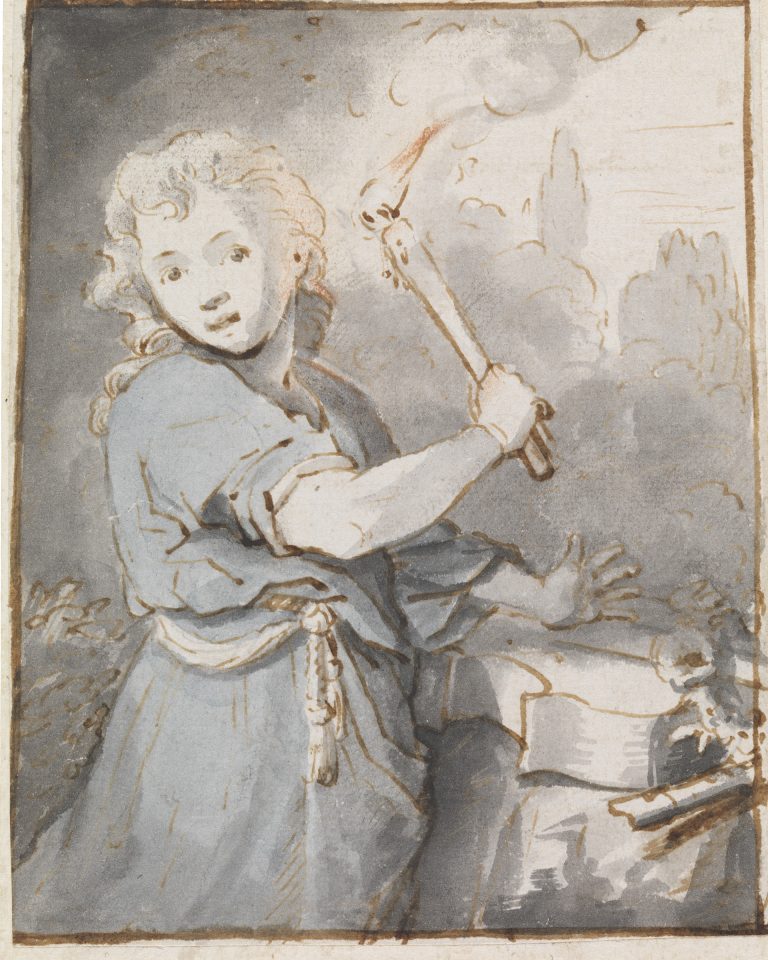The least known aspect of Godefridus Schalcken’s fairly extensive oeuvre is his work on paper. In addition to six prints, about 30 drawings have survived, mostly executed in red or black chalk and sometimes in pen and ink. A remarkable characteristic of these sheets is that almost all of them are portraits; moreover, they can often be connected with painted works, many examples of which have been pointed out by Beherman. Evidently Schalcken reached for his drawing stylus whenever clients asked him to paint their portraits. He must have begun to produce these drawings in the mid-1670s, around the time he was starting to make a name for himself as a portraitist. He continued this practice throughout his career.1 These portrait studies are striking in that there is practically no difference in style between the earliest and the latest known drawings: Schalcken clearly preferred to use chalk, and kept to the uniform style of hatching that constitutes another unchanging characteristic of his drawings.
The same unvarying style and materials can be seen in the rare studies Schalcken made in preparation for his genre paintings. One such sheet is Maid Blowing on Hot Coals for a Foot-Warmer, a red-chalk drawing made as a study for the painting in Braunschweig.2 Another example is an elaborate drawing in black chalk of Young Woman with a Burning Candle, Sitting in an Interior, made in preparation for the painting in Dresden.3 Maid Blowing on Hot Coals even bears a monogram, showing that Schalcken considered such sheets suitable for sale, which was certainly not true of his much sketchier portrait studies. Nevertheless, it is easy to see why the artist’s drawn oeuvre is so little known, for though it is skillfully executed, most of it is rather dry and unappealing.4
It is therefore all the more unusual to find a drawing such as the present study that shows a more sparkling—and hitherto unknown—colorful side to the artist’s drawn oeuvre. Young Boy, Dressed in a Blue Robe, Holding a Lighted Torch is obviously more sketchy in character. Moreover, the drawing is rendered in a technique not previously encountered in Schalcken’s work. He began this drawing in the usual way, using red and black chalk. On top of this, he loosely accentuated the most important contours with a pen and then, in a new departure, filled in the forms with gray and blue wash rapidly applied with the brush.5 The result is an extremely lively drawing, which outshines almost all of his other works on paper.
This previously unpublished sheet appears to be a study for Boy Holding a Torch in the Art Gallery of Ontario, Toronto (fig 1),6 a small painting on canvas supposedly dated 1692, a detail unconfirmed by the museum but certainly in keeping with the style of the work.7 Interestingly, there are many small differences between the drawing and the painting, which cannot be said of the drawing and painting of Maid Blowing on Hot Coals for a Foot-Warmer. In the Leiden Collection painting, the position of his head has been changed, and other differences from the drawing can be detected in his clothing and in the trees in the background. The most salient modifications are those made to the musical instruments at the lower right. In the drawing, the flute and what is probably a violoncello are placed considerably higher and more prominently than in the painting.
The provenance of the painting in Toronto goes back only to 1992–93.8 It can be identified, however, as the “portrait of Banister, the musician when twelve years old. In blue robes, holding a lighted candle, in a landscape,” which was sold at auction in London in 1941, after presumably being in the possession of the same family since the eighteenth century.9 It is, however, inconceivable that the painting, and therefore the drawing as well, portrays the English violinist and composer John Banister (ca. 1624–79),10 as he died long before Schalcken visited London for the first time. Yet this interpretation, which undoubtedly stems from the nineteenth century, suggests that such a scene—combining a boy holding a burning torch in a wooded landscape and several musical instruments—was rather unusual and therefore demanded an explanation.
Considering that the painting was long owned by the same English family, it is quite possible that Schalcken produced both the painting and the preparatory drawing in London, perhaps soon after settling there with his family in the spring of 1692. This dating puts the uncommon drawing technique seen here in a different light. It is possible that Schalcken, with an eye to a new and particularly interesting market of English collectors, made the drawing more elaborate and applied a colorful wash to produce a sheet that was both attractive and easy to sell.
